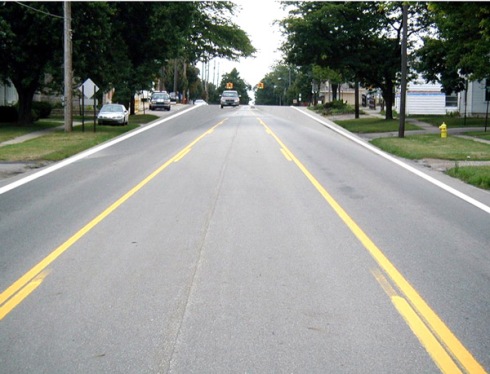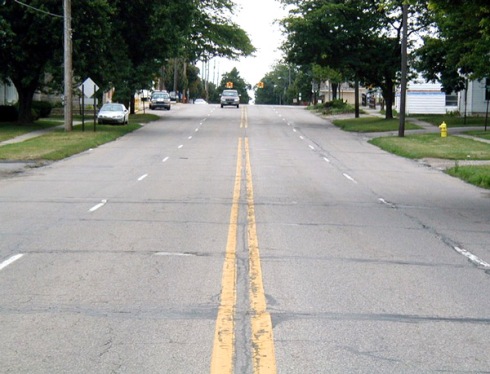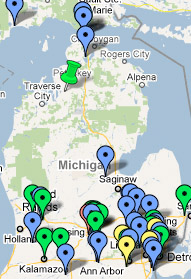You are currently browsing the tag archive for the ‘Road diet’ tag.
By Holly Madill, Complete Streets Project Coordinator - Michigan Department of Community Health

 Recent preliminary research from Paul Hamilton, Tri-County Regional Planning Commission, and Dave Morena, Federal Highway Administration (FHWA) Division Office suggests that Michigan could be the national leader in road diets and having road diet supportive policies in place. Analysis of in-state existing and planned 4 to 3 lane conversions (road diets) yields some early and impressive results:
Recent preliminary research from Paul Hamilton, Tri-County Regional Planning Commission, and Dave Morena, Federal Highway Administration (FHWA) Division Office suggests that Michigan could be the national leader in road diets and having road diet supportive policies in place. Analysis of in-state existing and planned 4 to 3 lane conversions (road diets) yields some early and impressive results:
- The Tri-County region (Clinton, Eaton, Ingham) has completed 15 miles of conversion from 4 to 3 lanes. An additional 18.5 miles of conversions are planned by 2035.
- The Genesee County Metropolitan Planning Commission has completed approximately 19.5 miles and released a 2009 Complete Streets technical report that depicts many more by 2035.
- The Michigan Department of Transportation has completed at least 45 miles of road diets on state trunklines around the state.
Hamilton and Morena have surveyed state DOT’s and regional transportation authorities across the country and found few places that compare to these numbers. Add in that Michigan has adopted Complete Streets laws and also has the highest number of local communities that have adopted Complete Streets policies, and one can quickly come to the conclusion that Michigan is becoming a progressive, national leader in active transportation.
Both the Michigan DOT and the FHWA Michigan Division office have stated that 4 to 3 lane conversions are operationally safe for roads with average daily traffic (ADT) or expected ADT of less than 15,000 vehicles per day, and both agencies are willing to explore conversions on roads with higher ADTs as well. To make it easier for communities to convert roadways from 4 to 3 lanes with traffic counts less than 15,000 vehicles per day, no further traffic studies are required to implement a conversion as long as they go through a robust and proactive public involvement process and meet other requirements of law, such as an air quality conformity analysis if they are deemed regionally significant.
According to Morena, in Michigan, the conversion of a road from 4 to 3 lanes does not affect the amount of Act 51 funds the local agency will receive from the state. Distribution of these funds is based on centerline road mileage, which is not affected by the 4-to-3 lane conversion.
This week the Washtenaw County Road Commission approved road diets (turning a four lane road into two traffic lanes, a center turn lane and bike lanes) for Golfside Road in Pittsfield Township and Ford Boulevard in Ypsilanti Township.
At the meeting opponents of the Ford Boulevard road diet argued that such a configuration would put them out of business, and that the number of crashes on Ford Boulevard were not all that many. Road Commission staff, however, pointed out that Ford Boulevard’s crash rate is much higher than it should be and that study after study has shown that road diets reduce crash rates.
Supporters of the road diets included League of Michigan Bicyclists, Washtenaw Bicycling and Walking Coalition, Bike Ypsi and Friends of the Border To Border Trail, all Michigan Complete Streets Coalition partners.
Construction on Ford Boulevard is expected to take place in 2011.
Road Diets are a cost-effective tool to calm traffic and reclaim street space for other roadway users such as bicyclists. With many Michigan roads built for to carry a larger amount of automobile capacity than they actually do, road diets are low hanging fruit opportunities for Complete Streets advocates to push for in their own communities.
Road diets, however, do not always go over well with the auto-centric public, as has been seen recently in Williamston and Jackson. It just goes to show why nonmotorized plans and Complete Streets policies are so important so these battles do not happen on a road by road basis.
We salute the Washtenaw County Road Commission for supporting the concept of road diets. They may find that adopting their own Complete Streets policy, as the Ingham County Road Commission recently did, may help demonstrate to the community a long-term commitment to building active transportation infrastructure.
Proving that we haven’t forgotten about Michigan’s upper half, we here at the Michigan Complete Streets Coalition want to share some good news from the Upper Penninsula’s most populous city.
Marquette residents awoke two weeks ago to find their city a bit more walk- and bike-friendly. On October 29th, road workers completed a resurfacing project on a one-mile portion of Wright Street, which runs east to west on the city’s north end.
Aside from resurfacing, the project also included work to reconfigure Wright Street, taking it from four lanes of traffic down to two lanes and a center turn lane, with room leftover to add four-foot wide bike lanes on either side. Engineers across the country are putting roads like Wright Street on a “road diet”, finding out in the process that their streets become leaner, safer, and more efficient.
Based on their comments, city officials seem hesitant about committing to the reconfiguration as anything more than a temporary experiment. But if the Wright Street experiment is anything like other road diet projects, city officials will soon be singing the praises of fewer crashes and improved safety. In fact, the data shows that using road diets and complete streets planning principles not only makes the our streets safer and more productive, it can also help encourage increases in commercial and residential property values, and can spur new development.
Kudos to Marquette city officials for taking that kind of risk.















